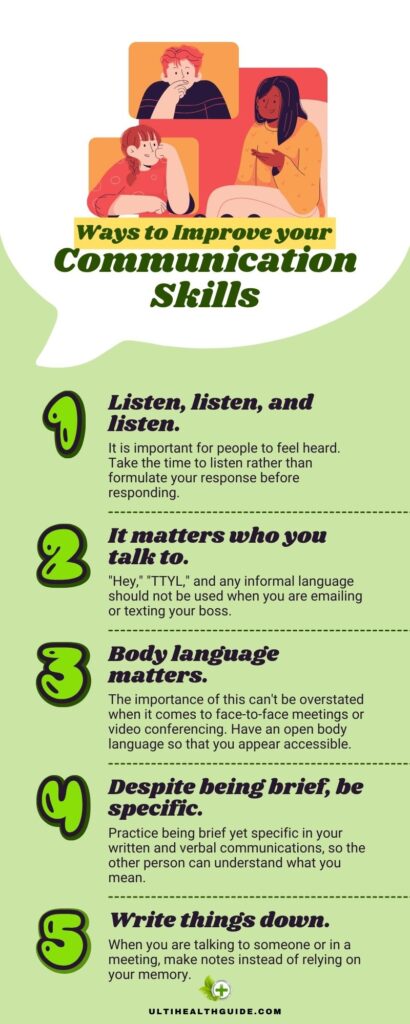Quick Reference
What Is Affective Communication?
Affective communication is the ability to communicate your feelings and emotions to others. It's essentially the ability to bridged the gap between thought and emotion. Affective communication is important because it allows us to build relationships with others, and it helps us to understand how others are feeling. It can also be helpful in conflict resolution, because it allows us to see things from the other person's perspective.
The Different Elements Of Affective Communication Skills
- Verbal Affective Communication
- Nonverbal Communication
- Facial Expressions
- Body Language
- Gestures
- Tone Of Voice
Tips On How To Communicate Affectively
- Listen actively and with an open mind. Try to understand peoples expressions without judging or interrupting them.
- Make eye contact, use facial expressions, and keep an open body posture to show that you are interested and engaged in the conversation.
- Use the "I" statements to express your own thoughts and feelings. For example, rather than saying, "You always make me angry," try "I get angry when you _ because I feel _."
- Avoid making assumptions about peoples is thoughts or feeling. Go ahead and ask them directly if you want to know.
- Take turns speaking and allow for pauses in the conversation. This will help you both to process what is being said and avoid interrupting each other.
Although communication is a fundamental part of life, emotion's role in communication is often undervalued. It is common to think of communication as primarily a verbal exchange of information. However, the affective content of communication – the emotions conveyed through language – can be just as important, if not more so.
Some experts have even argued that emotion is the most critical part of communication. For example, Jim Rohn, a legendary motivational speaker, once said, "Effective communication is 20% about what you know and 80% about how you feel about what you know."[1]
In other words, if you want to be an effective communicator, it's essential to be aware of the affective content of your communication and make sure that it aligns with your intended message.
Communication isn't just about exchanging information. It's also about how that information is conveyed - through our words, tone of voice, and body language.
This fact is known as affective communication, and it's a vital skill to have in any context, from personal relationships to professional ones.

What is affective communication?
The term "affective communication" consists of two words: affective and communication.
"Affective" refers to the emotions or feelings involved in a particular situation. "Communication," on the other hand, is the act of sharing information between two or more people.
In other words, affective communication is a type of communication that involves expressing feelings. It is the process through which people express their emotions and feelings about things, themselves, and others. When we communicate effectively, we are expressing opinions and self-disclosures. [2]
Affective communication differs from other types of communication, such as informative or instrumental communication, because it focuses on emotions rather than facts.
It can convey positive or negative feelings.
Positive affective communication includes expressions of love, gratitude, happiness, and pride. Negative affective communication includes expressions of anger, hatred, sadness, and fear.

The different elements of affective communication skills
Affective communication can be divided into two broad categories: verbal and nonverbal.
Verbal affective communication
This includes the use of words to express emotions. For example, if I say, "I'm feeling really angry right now," I am using verbal affective communication to express my emotion of anger.
Verbal communication includes:
- The words we use when we speak to others.
- Our tone of voice.
- The volume at which we speak.
Nonverbal communication
This involves the use of nonverbal cues to express emotions. Nonverbal cues can include facial expressions, body language, and tone of voice.
For example, if I have a frown on my face and speak in a low, aggressive voice, I am using nonverbal affective communication to express my anger.
Some typical example of affective communication includes:
- Facial expressions
- Gestures
- Body language
- Touching
- Eye contact
- Posture
We can use all of these elements to express our emotions and impact how another person perceives our message.
For example, if I try to come across as friendly and approachable, I might smile often and maintain eye contact. On the other hand, if I try to appear more authoritative, I might speak in a deeper voice and keep my body language open.
Let's examine each of these elements in more detail.

Facial expressions
Our faces are extremely expressive and can convey a wide range of emotions. From happiness and excitement to sadness and anger, our facial expressions provide others with essential cues about how we're feeling.
Facial expressions are also very compelling in influencing the feelings of others. This is likely because we mimic the expressions we see around us, a phenomenon known as emotional contagion. [3]
For example, if you see someone smiling at you, you'll likely feel more positive emotions.
Similarly, if you see someone with an angry or aggressive facial expression, you'll likely feel more negative emotions in response. So, if you want to appear approachable and likable, keep your facial expressions positive and open.

Body language
Body language is another crucial nonverbal cue. How we position our bodies can communicate a lot about how we're feeling and thinking.
For example, if someone stands with their arms crossed in front of them, they may feel defensive or closed off. Alternatively, if someone is leaning in towards you with an open posture, they may be interested in what you're saying.
It's important to be aware of your own body language, as well as the body language of others. When you're talking to someone, pay attention to their body language and see if it matches up with what they're saying. If someone's words and body language don't match, they may not be being truthful.

Gestures
One of the most important aspects of body language is gestures. Gestures are movements we make with our hands, arms, or head that can communicate various messages.
Extending a hand to shake someone else's can convey warmth or familiarity, while averting one's gaze can communicate shame, guilt, or lack of confidence.

Tone of voice
The tone of voice includes volume, pitch, rate, and inflection.
A person's tone of voice can reveal a lot about their emotions and attitudes. For example, an angry person may speak in a loud or aggressive voice, while a sad person may speak more quietly or with a lower pitch.
It is also essential to pay attention to the speech rate, as this can convey excitement, nervousness, or boredom.
Listening to these cues can help you better understand the other person's feelings and thoughts.

Touching
Paying attention to how someone uses touch can also be a powerful way to communicate. In some cultures, touching is seen as a sign of affection or camaraderie, while in others, it may be seen as disrespectful or intrusive.
Some people also use touch to emphasize their points or to show agreement, while others avoid touching altogether.
Affective communication is also linked to emotional intelligence(EI)—the ability to be aware of and comprehend your own emotions and those of others. People with high EI are typically better at communication because they can manage their emotions more effectively.
If you're looking to improve your emotional intelligence and communication skills, read our article on the 12 Scientific Steps To Raise Your Emotional Awareness.
The benefits of affective communication
In health care
Some research has shown that affective communication can lead to better doctor-patient relationships and improved patient compliance with treatment plans. [4]
Patients who feel a connection with their healthcare providers are more likely to follow treatment plans and adhere to medication regimens. When providers take the time to listen to their patients and understand their concerns, it builds trust and respect, which can make the overall healthcare experience more positive.
In education
In education, communication that considers students' emotional needs can be extremely beneficial. When educators can connect with their students on a personal level, it can create a more positive learning environment. When students feel supported and valued, they are more likely to be engaged in their studies and to perform better academically.
In family relationships
Many families find that communication becomes more difficult as their children grow older and lead more independent lives. Open and honest communication is essential in maintaining healthy family relationships. When family members can share their feelings, they can better understand and support one another.
In the workplace
The Impact of affective communication goes beyond our personal relationships. It also plays a role in the workplace. In the workplace, it is often common to interact with people with different perspectives and opinions. To be successful, it is important to be able to communicate affectively with these individuals.
When we can communicate our feelings and thoughts clearly and concisely, we will likely reach a compromise or agreement.
In romantic relationships
Couples who are able to express their emotions and feelings openly are more likely to maintain a strong connection with one another. Thus, fostering mutual understanding. Furthermore, affective communication can help to resolve conflict, build trust, and create a sense of intimacy.

Tips on how to communicate affectively
When we communicate affectively, we can express our feelings and needs clearly and assertively. We are also better able to understand the feelings and needs of others.
Good communication leads to deeper relationships, better understanding, and greater intimacy.
However, Learning to communicate affectively can be a challenge, but it is well worth the effort.
The following tips can help you to start communicating more affectively:
• Listen actively and with an open mind. Try to understand peoples expressions without judging or interrupting them.
• Make eye contact, use facial expressions, and keep an open body posture to show that you are interested and engaged in the conversation.
• Use the "I" statements to express your own thoughts and feelings. For example, rather than saying, "You always make me angry," try "I get angry when you _____ because I feel _____."
• Avoid making assumptions about peoples is thoughts or feeling. Go ahead and ask them directly if you want to know.
• Take turns speaking and allow for pauses in the conversation. This will help you both to process what is being said and avoid interrupting each other.
If you're looking to improve your communication skills, many great books can help.
In conclusion
Affective communication is an integral part of our everyday lives. Each of these types of communication can convey our emotions in different ways. For example, we might use a specific tone of voice when angry or make a particular gesture when happy. Affective communication is used in all aspects of life, including family, friends, co-workers, and strangers.
It is a way of building relationships, solving problems, and creating understanding between our conversation partners. It can result in improved relationships, increased cooperation, decreased conflict, and increased social health.
By being aware of the different ways we can communicate emotionally, we can better understand and respond to the needs of those around us.
To learn more about social health, What Is Social Health? Examples, And 7 Tips On How To Achieve It.
FAQ
What Is Effective Communication?
Effective communication is the process of sending and receiving messages in a way that is clear, concise, and easily understood by the receiver. It can be verbal (spoken), nonverbal (body language), or written.
Is It Effective Communication Or Affective Communication?
Affective communication is sending and receiving information to evoke an emotional response. Effective communication, on the other hand, is communication that achieves its purpose. While affective communication is a type of effective communication, not all forms of effective communication are affective.
What Are Affective Communication Strategies?
Affective communication strategies are ways of communicating that take into account the emotional responses of the people involved. Common affective communication strategies include Active listening, Nonverbal communication, Empathy, and Validation.







